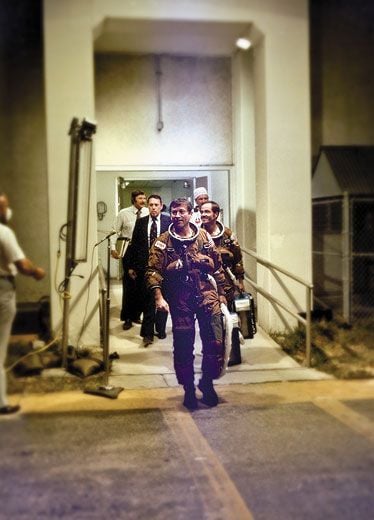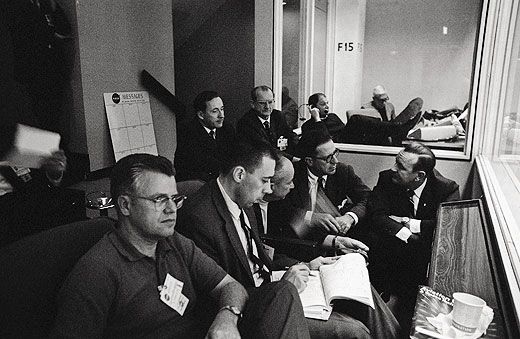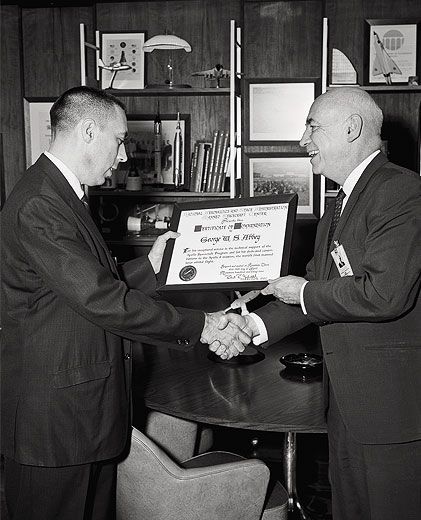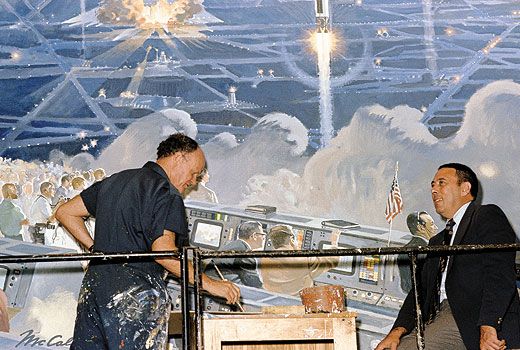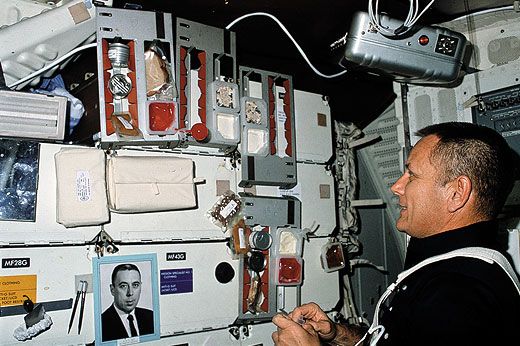Mr. Inside
George Abbey had more influence on human spaceflight than almost anyone in history, but few outside the field know his name.
/https://tf-cmsv2-smithsonianmag-media.s3.amazonaws.com/filer/Mr_Inside_6_FLASH.jpg)
To watch George Abbey move through a Houston evening is like tagging along with an ex-mayor on a tour of his city—in this case the neighborhood around the Johnson Space Center, home of NASA’s astronaut corps. When Abbey enters a club, people’s heads turn. One person offers a handshake and a shared memory. Another asks a favor. Seeing familiar faces, Abbey remembers birthdays, parents’ names. He ventures opinions, none of them remotely guarded (“He’d make a great chief engineer for JSC”), then gives advice to a young engineering student hoping to study at the Moscow Aviation Institute.
Now in his late 70s, Abbey has been retired from NASA for nearly a decade. With his hooded eyes, close-cropped silver hair, and solid build, he looks like an amiable grandfather, which in fact he is. His NASA career spanned 39 years, from the earliest days of Apollo to construction of the International Space Station. Despite working at the highest ranks of the agency, he was rarely interviewed, or even written about. When he was, it wasn’t always flattering. Abbey was characterized as dictatorial; former astronaut Norman Thagard called him “a Godfather type.” Another retired shuttle astronaut, Mike Mullane, wrote that astronauts thought of him as “a rapacious power monger.”
And yet…
“George Abbey saved the space program four times,” says his former boss, legendary flight director Christopher Kraft. Richard Truly, an astronaut who became NASA’s administrator, once said, “The real book about the manned space program would be a book about George Abbey.” Another veteran astronaut calls Abbey “the best program manager NASA ever had.”
Which is it? Was Abbey some kind of space age Zelig, appearing whenever NASA needed a savior? Or a shadowy puppet master who bent administrators and astronauts to his will?
George William Samuel Abbey grew up in Seattle, watching airplanes take off from the nearby Boeing plant. Hoping to become a naval aviator, he attended the U.S. Naval Academy, but switched to the Air Force after graduation so he could go directly to flight school without first doing sea duty. Stationed at bases in Texas, he flew both helicopters and fixed-wing aircraft, including the Lockheed T-33 and North American B-25 Mitchell. Eventually he would log more than 5,000 hours of flying time.
Aircraft, though, were just a stepping stone to space. “I liked Buck Rogers” is Abbey’s simple reason. One night in October 1957, “I was driving across the northern states, probably somewhere in Montana. And I stopped to watch Sputnik cross the sky. I heard the beeping on the radio. I knew this was significant.”
A year later, he entered the Air Force Institute of Technology in Ohio to work on a master’s degree in electrical engineering. After graduation, he was assigned to the X-20 Dyna-Soar spaceplane program, ending up as technical liaison at the Boeing plant in Seattle. When that project was cancelled in 1963, Abbey stayed at Boeing, working first on the Super-Sonic Transport, then on NASA’s Lunar Orbiter. Eventually, with the Apollo program ramping up, the Air Force detailed him to the space agency.
Assigned to work on the Apollo Block II (lunar version) spacecraft, Abbey got first-hand exposure to the financial, technical, and political battles between NASA’s Manned Spacecraft (later Johnson Space) Center and North American Aviation, the prime Apollo contractor. James Wetherbee, who years later would serve as deputy director of JSC under Abbey, says of this period, “North American had to make a big decision [about spacecraft requirements], and nobody from NASA would step up. George was quite junior, but he had weighed the information, and made the decision. And that’s how he got noticed.”
Soon he was working for Joe Shea, head of the Apollo spacecraft program. Still, Abbey hadn’t forgotten about Buck Rogers, and when NASA began searching for new astronauts in 1965, he applied. He failed to make it past the Air Force screening process. “The Air Force wouldn’t consider you unless you had attended the Aerospace Research Pilot School,” he says. “The Navy didn’t have that requirement. Had I been a Navy pilot, it might have turned out differently.”
So it was back to working for Shea. On January 26, 1967, the Apollo manager and Abbey visited Cape Kennedy, where the Apollo 1 crew of Gus Grissom, Ed White, and Roger Chaffee were preparing for a launch pad test. The next day, as Shea and Abbey were flying back to Houston, the astronauts climbed into the Apollo command module. Late in the afternoon a fire broke out in the spacecraft’s pure-oxygen atmosphere, killing all three men and bringing the Apollo program to a wrenching halt.
“It was just devastating,” Abbey remembers. “A complete surprise, since it was a test, not a flight. The nature of the accident made us that much more aware that, in human spaceflight, you’ve got to get it right. You’ve got to pay attention to details, because if you don’t, people can die.”
In the aftermath of the accident, Abbey and astronaut Frank Borman worked around the clock with the team trying to determine the cause of the fire. Under the pressure and the long hours, Shea, who faced a potentially hostile investigation, began to unravel. By April, with headquarters officials worried about his mental health, Shea was asked to step down as Apollo spacecraft manager, and was replaced by NASA veteran George Low, who named Abbey as secretary of the high-level board that approved all changes to the Apollo spacecraft. With Low’s encouragement, he resigned his Air Force commission and became a NASA civil servant.
Between June 1967 and the first moon landing, in July 1969, the Apollo Configuration Control Board met every Friday, beginning promptly at noon and continuing, says Abbey, “until the agenda was completed, however long that took.” All department heads—Max Faget from engineering, Kraft from flight operations, Deke Slayton from the astronaut office, Charles Berry from medical—had to be present, along with representatives from the contractors. Abbey’s job was to take notes, synthesize them into a list of action items, and have the list ready on Saturday morning. Every important issue came to the CCB, from design of the command module hatch to the decision to send Apollo 8 around the moon. It was not glamorous work. Astronaut Thomas Mattingly first met Abbey around this time; “He was introduced to me as a secretary,” he recalls. “That wasn’t too impressive.”
Watching Low and Abbey operate, however, Mattingly realized “they had developed the perfect management system—a combination of high and low.” The boss listened to formal, top-level presentations, made decisions, and worked with other NASA leaders to carry them out. Abbey gathered the raw intel in bars and coffee shops. “George held court every night,” Mattingly says. “All he would do is ask, ‘What’s going on? What are you doing?’ [That] could give you a lot of useless information. But he recognized what was important—or better yet, what was different from what Low was hearing.
“He would take this information to Low, who would [then] ask a casual question of an engineer: ‘Hey, I’m having a tough time understanding something. Could you help me with it?’ Often, just the fact that Low was focusing on an issue was enough to make things happen and shake out the right answers.”
Under Low’s guidance, Apollo returned to flight, orbited the moon in December 1968, and fulfilled President Kennedy’s pledge to land astronauts on the lunar surface before the decade was out. In the fall of 1969, with NASA focused on carrying out the rest of the Apollo missions, Abbey became technical assistant to Robert Gilruth, director of the Manned Spacecraft Center. When Gilruth retired, Abbey filled the same role for new director Chris Kraft. “I wanted George as my assistant because he knew all the center skeletons, where all the bodies were buried,” says Kraft. “I knew he could get people to do what the boss wanted.”
How did Abbey develop his network? By literally going to every building and office—whether it was engineering, accounting, or plumbing—and finding out who worked there. He took down names and got to know the individuals. No one told him to do it. “I realized that I needed to have a better idea of what the other offices did,” Abbey says.
He served as Kraft’s technical assistant for four years. He was there during the Apollo 13 crisis—he made the phone call telling Gilruth of the explosion on the spacecraft—and was part of the team that earned a Presidential Medal of Freedom for bringing the astronauts home safely. As usual, his work was largely behind the scenes; no George Abbey character appears in the Ron Howard movie. He was, in the words of Rockwell’s George Jeffs, who worked with Abbey for two decades, “the perfect staff man.”
In the lull that followed Apollo, Kraft turned to solving a long-standing problem: the astronaut office. “I had tremendous affection for Deke Slayton [the Mercury astronaut who ran flight crew operations from 1964 to 1973],” says Kraft. “But there were things I wanted done differently. Deke protected the astronauts, was not cooperative with other divisions at the center, including medical and public affairs, and was just too damn secretive about his decisions.”
One day in January 1976, Abbey walked into Kraft’s office and was told, “You’re the new director of flight operations.” Suddenly he was in charge of several hundred people, including the astronauts and flight directors who had just pulled off the moon landings, one of the most daring technical feats of all time.
If Abbey was intimidated, he never showed it. “I knew these people fairly well, having worked with them for a dozen years,” he says. “I came from a similar background too. I knew we could work together.” One immediate challenge was to recruit a new generation of astronauts to fly the planned space shuttle. Kraft felt strongly that the corps should be open to women and minorities, and that didn’t sit well with some of the old guard. Slayton worried about finding qualified candidates, and walked out of the first meeting at which the topic of recruiting minorities came up. “He never came back,” says Abbey.
The “Thirty-Five New Guys”—including six women—who would make up the early space shuttle crews were announced in January 1978. NASA put out another call for astronauts in 1980, and three more in the seven years following. Each time, the man overseeing the selection was George Abbey.
It was in that role that he drew the most criticism. Some astronauts complained they were never sure how they were being judged. Would Abbey mark you down for poor performance on a sim? Failure to follow aircraft flight rules? Personal behavior? Some believed, according to payload specialist Drew Gaffney, that “you had to suck up” to Abbey “to go up.”
James Wetherbee, who has heard the criticism, is “dumbfounded” by accusations of favoritism. “You didn’t have to be a rocket scientist to know how to succeed,” he says. “You buried your nose in your workbooks, you talked to people, you studied the systems, you trained. If you did that, you were rewarded.”
Three-time shuttle flier Rick Searfoss says, “There were three types of astronauts…those George liked, those he didn’t, and the vast majority who were in the middle, just solid citizens. That [middle] was where you wanted to be.” If Abbey liked you too much, says Searfoss, you could “wind up with some interesting management job that would take you away from flying for a couple of years.”
While Abbey counted some astronauts as personal friends, who would get together for regular Friday afternoon happy hours, he says that never affected flight assignments. He simply matched a list of available astronauts to the schedule of missions and requirements, and that was it.
Flight selection may have been a closed-door secret to the astronauts, but on launch day, Abbey was very visible. He rode to the pad with each shuttle crew, and was standing on the runway to shake the astronauts’ hands when they landed. He and Chief Astronaut John Young held a private postflight briefing with every mission commander, to hear about any problems that might have come up, or improvements that might be made. “They wanted all the details, good, bad, and ugly,” recalls Searfoss.
When it came time to pick a shuttle crew, Abbey took special pleasure in delivering the news, often in unexpected ways. He told Robert Crippen after a routine T-38 training flight that he’d been assigned as pilot to the coveted first mission: STS-1. Sometimes Abbey would call an astronaut in the middle of some non-flight-related job: “Are you happy doing what you’re doing? Would you be interested in flying?” Often a group of five astronauts would receive separate summons to his office…only to realize on the walk over that they were now a shuttle crew.
Shuttle commander Hoot Gibson, a former chief of the astronaut office, says, “George treated us like children. He acted as though he was our father, often making decisions we would rather have made ourselves.”
The Challenger disaster hit Abbey hard. “Apollo was bad—a shock—but Challenger was worse, because I saw it happen,” he says. He had ridden to the pad with the crew as usual, and returned to the control center assuming the launch would be postponed due to ice on the pad. He was amazed to hear that the launch was “go” anyway. He watched in horror as Challenger broke up 73 seconds after liftoff.
“I immediately gathered the [astronauts’] families, got them off the roof of the center and into the crew quarters,” he recalls. “I was the one who had to tell them that the accident was probably not survivable.” It was a bitter time, all the more so because Abbey had never liked the idea of using solid-rocket boosters for a manned vehicle, and had not even heard of the arguments about O-ring safety at NASA’s Marshall Spaceflight Center.
In the aftermath of the tragedy, NASA got a new administrator, James Fletcher, who ordered sweeping changes at the Johnson Space Center. Young was replaced as chief astronaut, and Abbey was transferred to NASA headquarters in Washington, D.C., where he soon found himself deputy associate administrator for spaceflight under former astronaut Bill Lenoir—who was not a fan. “George is an extremely smart person,” Lenoir said years later. “Very good team player as long as it’s his team and he’s in charge. Not a good team player on anybody else’s team, and I could never get him to play by my rules.”
In 1991, Abbey was detailed to the White House’s National Space Council, where he was able to advocate for NASA during a difficult period, when the shuttle was plagued by delays and the Hubble Space Telescope’s misshapen mirror had tarnished the agency’s image. The following year brought another new agency administrator, Dan Goldin, a program manager from TRW who knew relatively little about NASA. Goldin made Abbey his special assistant, and for the next two years, the pair formed a united persona privately referred to as “Chief Dan George.” It was during Goldin’s first year that Abbey made his most remarkable—and least known—political contribution.
Abbey had never been a fan of the proposed Space Station Freedom. He knew that its $8 billion price tag was unrealistic, and thought the program unnecessary. The Soviets already had a space station, Mir, and “I thought that going back to the moon and on to Mars could have been accomplished without duplicating the Soviet effort,” he says.
In 1993, with Freedom’s budget growing and its capability shrinking, President Bill Clinton asked Goldin to come up with a cheaper space station. Abbey pulled together a small “tiger team” of old Apollo hands—John Young, Tom Stafford, and Max Faget among them—who met with Goldin and Abbey in Stafford’s office in Alexandria, Virginia. Over a single weekend in April 1993, working with yellow pads and Legos, the group came up with a new modular space station. Russian modules could be used in addition to some of the ones already planned for Freedom. Phase 1 of the new partnership would be a series of U.S. shuttle flights to the Russian Mir station. Abbey’s tiger team didn’t invent the International Space Station, but, with the Russian partnership, they figured out a way to get it built. The White House approved the plan.
In 1996, Abbey finally landed the job he’d wanted for 20 years—director of the Johnson Space Center. The ultimate staffer was now in charge of U.S. human spaceflight.
Alan Ladwig, a longtime NASA official who worked with Abbey in Washington in the early 1990s, says, “George had a reputation for being quiet—not speaking, mumbling even. I’m not convinced that wasn’t some sly-like-a-fox strategy. He could be very forceful.”
Forceful he was in his new job at JSC, changing personnel, cancelling contracts, and making numerous enemies along the way. Befitting the leader of a large organization, he played an active role in the center’s life, building relationships with local politicians and promoting social events. He even arranged with the Long Horn Breeders Association to graze a herd of cattle on a JSC field.
For all his bureaucratic and political skills, he was also involved in engineering decisions. From 1995 to 2001, among the shuttle program’s busiest years, Abbey chaired all the Flight Readiness Reviews, working through long lists of technical items before each flight. When the International Space Station faced delays due to problems on the Russian side, it was Abbey who fought for end-to-end software testing on the ground before launch. The tests uncovered a number of problems that would have been difficult to fix in orbit.
There was one problem Abbey didn’t fix, however. In early 2001, news of a $4 billion cost overrun on the ISS embarrassed the agency just as the George W. Bush administration was coming into office. Declaring that “there needs to be reform in human spaceflight,” Administrator Goldin removed Abbey from the JSC director’s post. In January 2003, Abbey left NASA for good.
Today he is a fellow at the James Baker Institute of Houston’s Rice University, where he researches and writes policy papers and arranges seminars. He takes time for travel, visiting family in Europe and attending Celtic music festivals. He’s still not afraid to speak his mind. He thinks the shuttle should have kept flying for another five years, and—always an advocate of international cooperation—believes China should be invited to join the space station partnership.
Abbey is a modest man. He doesn’t think about his legacy, and says he isn’t aware he even has a legacy. If Abbey had a credo, though, it would probably be this: Gather as much information, technical and personal, as possible. Know the individuals and the procedures. Make the decision. Dispense punishment in private. And stay out of the limelight. That’s for others.
Michael Cassutt is a novelist and television writer in Studio City, California. His latest novel is Heaven’s Shadow (Ace, 2011), a collaboration with David S. Goyer.
/https://tf-cmsv2-smithsonianmag-media.s3.amazonaws.com/filer/4b/6f/4b6f9955-ed5d-4cbf-b07c-deab888e40e7/abbeycoleman.jpg)
